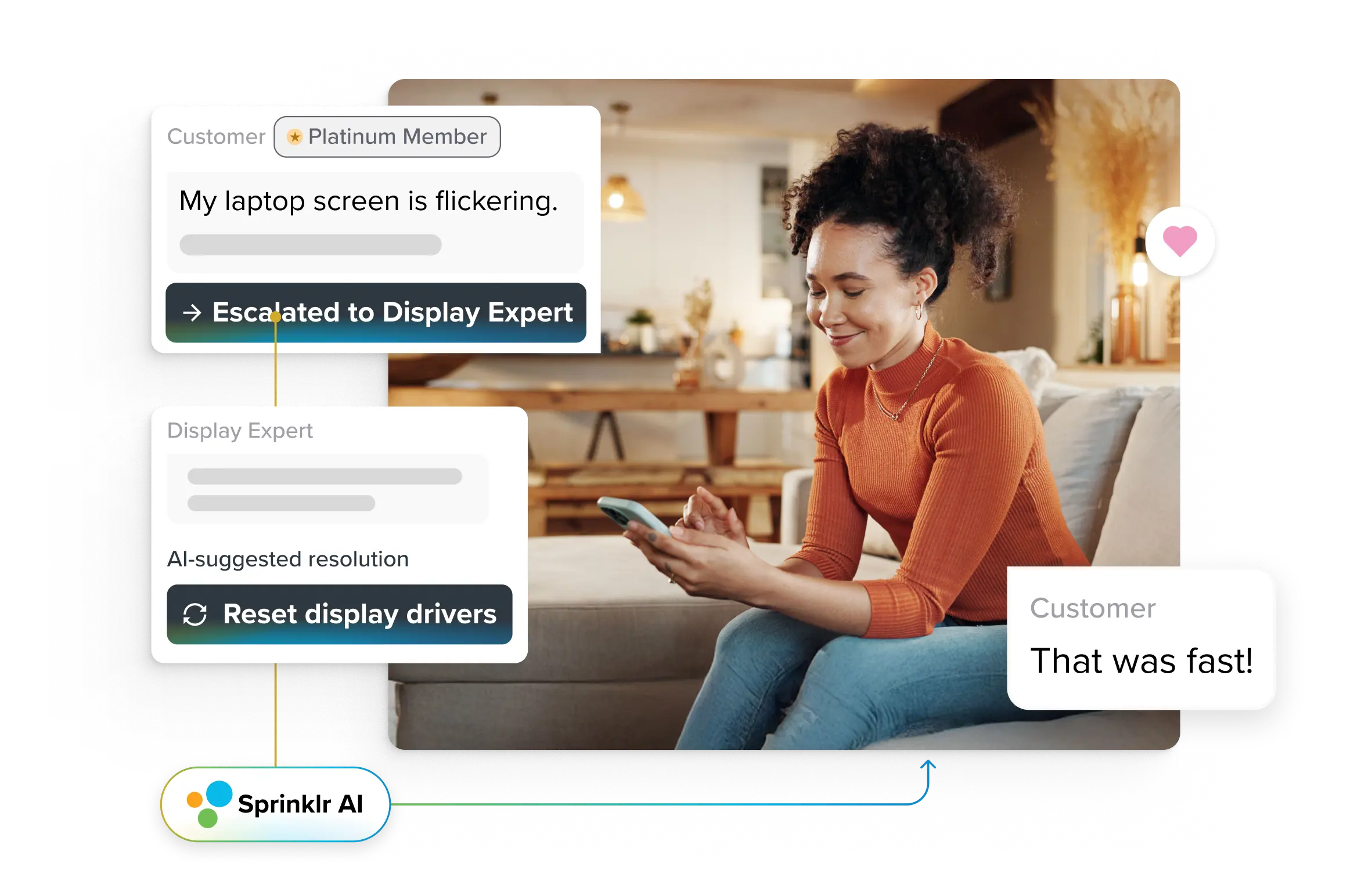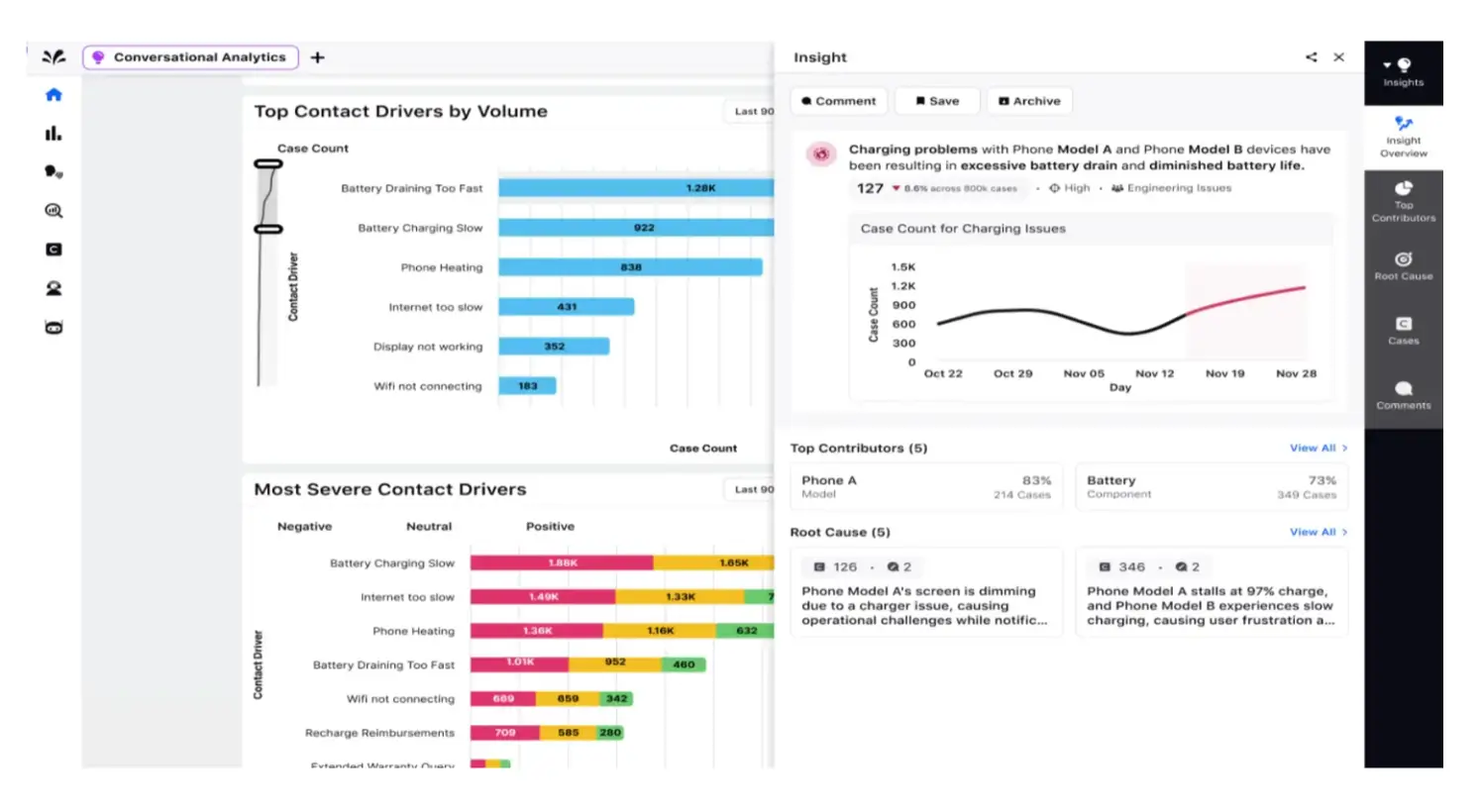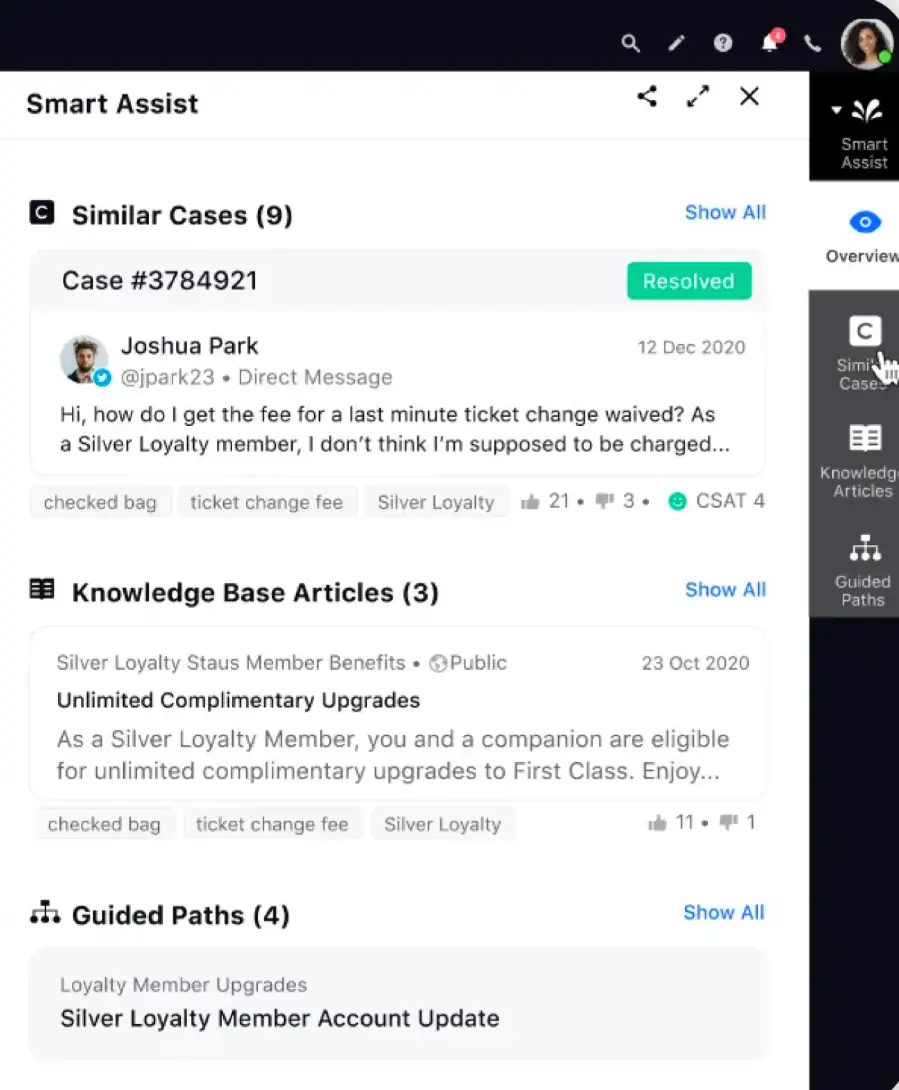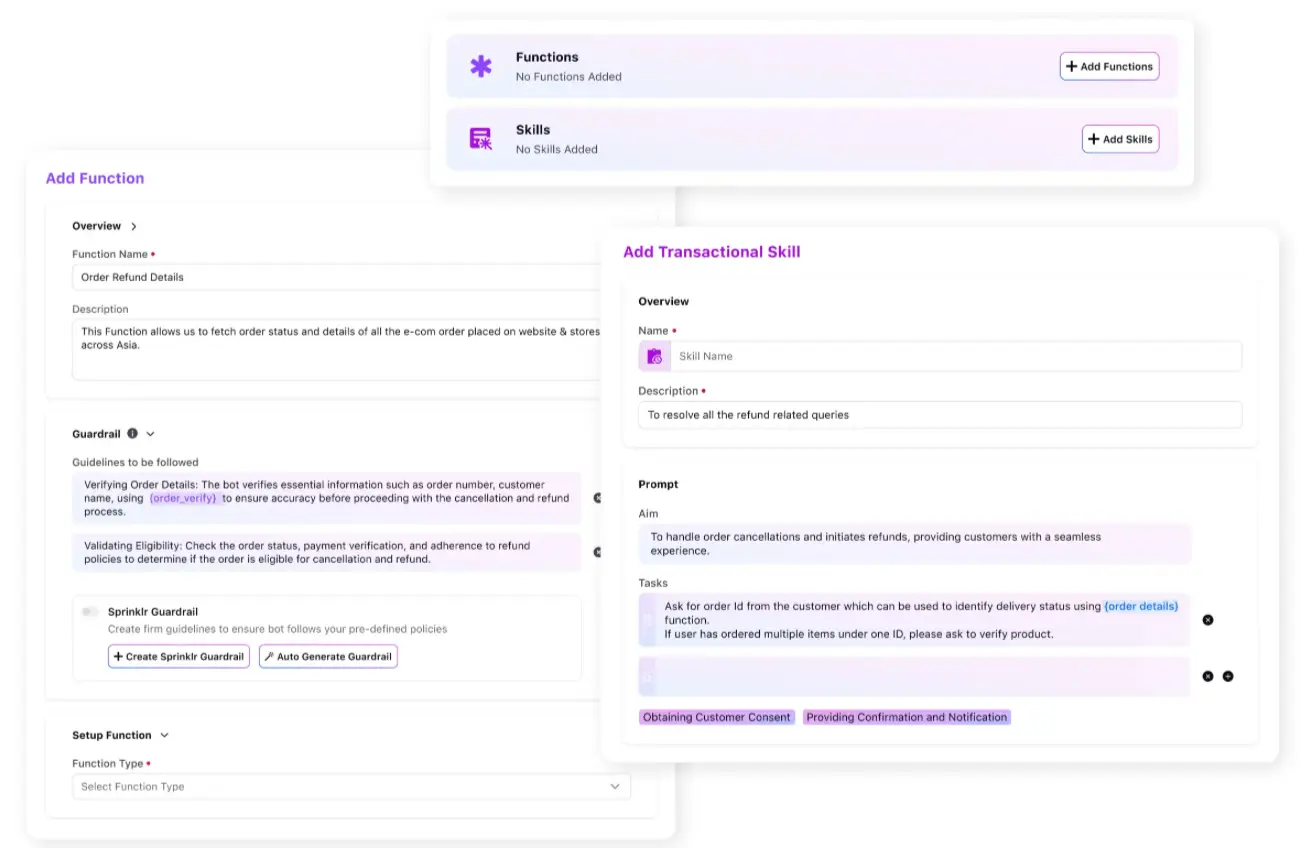Transform CX with AI at the core of every interaction
Unify fragmented interactions across 30+ voice, social and digital channels with an AI-native customer experience platform. Deliver consistent, extraordinary brand experiences at scale.

Conversational AI: Use Cases, Implementation Steps and Future Trends
It used to be subtle.
AI quietly worked in the background, refining your Netflix queue, tagging photos, and personalizing ads. But that era is behind us. AI has found its voice today, and it is speaking directly to your customers.
Today, conversational AI has evolved far beyond chatbots and voice assistants. It has become a strategic layer that rearchitects how brands and customers connect across every digital touchpoint, in real-time, and at enterprise scale.
Whether it's resolving complex service issues in seconds or guiding customers to the right product with contextual prompts, conversational AI is now table stakes for a generation that values immediacy, personalization, and control.
And the shift is measurable: 38% of Gen Z and millennial users now prefer self-service tools powered by AI, expecting fluid, human-like interactions from the brands they trust.
For enterprise businesses, this is both an opportunity and a challenge. As customer experience (CX) cements itself as the top competitive differentiator, the focus shifts from simply deploying AI to designing conversations that feel effortless, helpful, and distinctly human.
In this article, we'll unpack what conversational AI really means in an enterprise context — how it works behind the scenes, how it's reshaping CX at scale, and how to design and deploy it right.
- What is conversational AI and how does conversation with AI work?
- Top 3 business benefits of conversational AI
- Key enterprise use cases where conversational AI technology delivers results
- 7 steps to implement conversational AI successfully
- Top trends shaping what’s next for conversational AI
- The future of conversations is balanced, not binary
What is conversational AI and how does conversation with AI work?
Conversational AI is the technology that enables machines to simulate natural, autonomous conversations with people, not through rigid scripts but through adaptive, human-like exchanges.
It powers the voice assistants on your phone, the chatbots on retail apps, and the AI-powered virtual agents in modern enterprise contact centers. These systems don't just respond; they interpret, learn, and engage in real-time.
But what feels like a fluid conversation on the front end is powered by a sophisticated customer service technology stack operating behind the scenes. Here's a breakdown of the key components working together:
- Natural language processing (NLP): Deciphers the user's intent even when the input is messy, emotional, colloquial, or riddled with typos. It helps the AI "understand" what the user meant, not just what they said.
- Machine learning enables the system to learn from new customer interactions continuously. The more it engages, the better it becomes at predicting intent, optimizing dialogue flow, and improving outcomes over time.
- Automatic speech recognition (ASR): Converts spoken language into structured text. This is the foundation for voice-based interfaces like virtual agents or IVRs.
- Large language models (LLMs): These advanced AI models — like GPT or proprietary enterprise LLMs — generate fluent, contextually relevant, and human-sounding responses. They enable systems to hold multi-turn conversations without losing context.
- Dialogue management: Orchestrates the flow of the conversation. It determines what the system should say next when to ask clarifying questions, when to escalate, and how to handle interruptions or unexpected inputs in a graceful manner.
📈 According to Gartner, by 2026, AI will automate one in every ten customer service interactions. But automation doesn’t have to come at the cost of experience. Conversational AI is one of the few technologies that delivers both efficiency and customer empathy.
Here’s a quick comparison of how scripted, rule-based chatbots differ from modern conversational AI in real-world customer interactions.
Scenario | Scripted chatbot response | Conversational AI response |
Order status inquiry Customer: “Hi, I placed an order last week and haven’t received it yet.” | “Please enter your order number to proceed.” | “Got it — sounds like you're checking on a delayed delivery. If you share your order ID, I can pull the status. Also, do you want SMS updates if the delivery is rescheduled?” |
Billing dispute Customer: “Why was I charged twice on my credit card this month?” | “For billing help, press 1. For technical issues, press 2.” | “I see there’s a duplicate charge on your last invoice. Sorry for the inconvenience. Let me check with billing and get this sorted. Would you prefer a refund or a credit for next month?” |
IT helpdesk (Internal) Employee: “VPN keeps disconnecting every 5 minutes.” | “Please restart your router and try again.” | “Thanks for flagging this. You're not the only one facing VPN drops today. I’ve logged your issue and escalated it to IT. In the meantime, want to switch to backup access?” |
Also Read: 7 Customer Service Scenarios with Tips & Examples
Top 3 business benefits of conversational AI
You now understand how conversational AI works. But what does it deliver when deployed at scale? Here's how it moves the needle on customer experience, operational efficiency, and global reach right where it matters most for modern enterprises.
- Faster resolutions lead to higher satisfaction and loyalty
Speed and personalization are no longer differentiators; they’re expectations. A 2025 cross-sector study on chatbot adoption in retail, banking, and telecom found that customers reported significantly higher satisfaction when engaging with conversational AI, especially when interactions felt personalized and efficient. Repeat users even rated their overall experience better than those assisted by human-only channels.
The reason is that conversational AI reduces friction. It understands context fast, recalls historical data, and skips the scripted small talk. No more “Please hold” or “Can you repeat that?” — just intelligent, relevant responses in real time. This immediacy translates directly into measurable CX impact: improved customer satisfaction, higher NPS, and stronger customer retention.
➕Additional Read: Good Customer Service: All That It Takes in 2025 (+Tips)
- Offload routine work and boost agent productivity
When AI handles high-volume, low-complexity queries, your contact center agents are freed up to solve the hard stuff.
A field study involving over 5,000 support agents who used generative AI tools showed a 15%+ increase in productivity, measured by the number of issues resolved per hour. Junior agents benefited the most — improving not only their speed, but also the quality of their responses.
This means faster onboarding, fewer escalations, and less burnout across your contact center workforce. Instead of reacting to tickets, agents can focus on high-empathy, high-impact moments that require critical thinking and human judgment.
📂 From the Vault: How Your Contact Center Can Leverage AI to Improve Agent Productivity and Boost Morale
- Scale global support with native-like fluency
Your customers don’t all speak the same language — and they shouldn’t have to.
Modern conversational AI platforms are trained across multiple languages, dialects, and cultural norms. While responding to queries, they adapt customer service tone, phrasing, and even etiquette to match regional expectations.
Whether your customer is in Tokyo, Toronto, or Tunisia, conversational AI enables consistent, human-like support without fragmented regional ops or patchy translation layers. For enterprises, this means scaling globally without compromising personalization and leveraging language diversity as a growth enabler rather than a cost center.
📌Must Read: Multilingual Customer Support: A Guide to Provide and Improve It
Key enterprise use cases where conversational AI technology delivers results
Conversational AI is meant to empower most of your enterprise divisions, not just for support and service. Here are a few use cases.
Department | Enterprise use cases | Example |
- Handles tier-1 queries like password resets, order tracking and FAQs. - Prioritizes tickets using sentiment analysis (e.g., angry tone, repeated complaints) and urgency markers, then escalates to live agents based on complexity and customer value. | An Asia-based fintech brand deployed conversational AI across chat and social channels, resolving 274,000+ cases autonomously. 📈 Impact: Increasing customer query volumes were ably handled without requiring additional hires, resulting in cost savings equivalent to 5.35 full-time employees. | |
Human resources and IT | Automates onboarding (policy walkthroughs, document collection), FAQ resolution, and IT support, such as password resets or VPN issues, through internal enterprise chat systems. | Accenture uses an internal AI bot to manage onboarding, schedule interviews, screen candidates, and send real-time updates. 📈 Impact: Faster hiring cycles, improved first-day experiences, and fewer rejections due to process delays. |
Sales and marketing | Surfaces lead insights (e.g., buying signals, past behavior), suggests talking points and gives real-time nudges like promo reminders, competitor mentions or next-best-offer tips.  | Starbucks’ DeepBrew platform uses AI to personalize offers, recommend products, and automate marketing outreach. 📈 Impact: Increased campaign precision, stronger customer engagement, and measurable lift in customer loyalty and repeat sales. |
Global CX operations | Enables real-time translation across languages and dialects. Adapts to regional context across channels like chat, email and voice, at a global scale. | A Middle Eastern fashion retailer deployed AI to enable self-service in 6+ languages (Arabic, English, Hindi, Urdu, Punjabi, etc.). 📈 Impact: 175% faster resolution, 50% drop-in abandonment rate, and consistent improvement in CSAT across geographies. |
7 steps to implement conversational AI successfully
You’ve seen how conversational AI boosts satisfaction, scales support, and sharpens operations. But turning that potential into real results depends on execution.
Here’s your strategic blueprint for doing it right, not with generic best practices but with moves that deliver in enterprise settings.
Step #1 Start with a conversation flow audit — Not the tech stack
Before you plug in a chatbot or fine-tune a model, pause and ask: What are my customers actually saying?
Audit your current support channels — live chat, email, IVR, WhatsApp, social DMs — and identify:
- High-volume, low-complexity intents (FAQ-type queries)
- Repetitive friction points or resolution loops
- Escalation triggers and agent handoff patterns
- Language and tone variations (emotional signals, sarcasm, urgency)
Utilize tools such as intent classification models and conversational analytics to categorize queries. Track touchpoints per resolution and abandonment hotspots. This tells you where automation adds value — whether it’s reducing AHT, improving containment, or enhancing CSAT.
💡Expert Speak
If you skip this step, you risk automating noise or oversimplifying complexity. Let your customers’ intent and words guide what AI should do — not the other way around.
That’s exactly where conversational analytics can accelerate your audit. Instead of manually tagging thousands of chats or calls, you can use AI to automatically surface contact drivers, customer personas, and intent clusters — complete with root causes and recommended actions.
Sprinklr’s conversational analytics helps you do just that — combining real-time insights with persona-level analysis so you know what to automate, where to deflect, and how to design conversations that actually move the needle.

Step #2 Define outcomes, KPIs, and use cases that actually matter
Remember that conversational AI platform implementation isn’t about launching a chatbot. It’s about achieving specific business outcomes.
Define what success looks like:
- Fewer tier-1 tickets?
- 30% improvement in first-response time?
- Higher NPS post-AI interaction?
Map each outcome to a measurable KPI: deflection rate, FRT, CSAT, resolution accuracy, or cost per contact. Then, connect those KPIs to practical use cases such as:
- Automating FAQs and password resets
- Triaging inbound support by customer sentiment and value
- Personalizing product discovery in digital commerce
🎯 Pro Tip
Start small but scalable. Nail 2–3 high-impact use cases before expanding across functions.
Step #3 Feed clean, representative training data — and govern it relentlessly
Conversational AI is only as smart as the data you feed it. Garbage in, garbage out, and in enterprise contexts, that’s a costly mistake.
A 2024 empirical study found that incomplete, erroneous, or inconsistent training data leads to unreliable AI models and poor decision-making. High-quality data (accurate, complete, and consistent) is essential for trustworthy, high-performing AI applications.
Start by curating clean, relevant conversation data across your chat, email, call logs, and CRM notes. This helps your AI understand real-world queries, slang, edge cases, and variations in tone. Tag inputs accurately, strip sensitive PII, and continuously update your training sets as customer behavior evolves. But good data alone isn’t enough. You also need tight governance.
Establish clear rules regarding data access, model retraining, and ethical boundaries to prevent hallucinations or biased responses. This ensures your AI doesn’t just sound smart; it stays reliable, fair, and on-brand.
💡Do you know
Many AI failures stem from training on “ideal” transcripts rather than messy, real-world customer language. Train on reality, not theory.
Step #4 Build fallback logic and escalation workflows
No AI can answer everything, and that’s okay. What matters is how it recovers. Smart conversational AI knows when it’s out of its depth. That’s where fallback logic comes into play. If a bot misses intent or detects confusion, it should instantly shift to clarifying questions or hand it over to a human without forcing the user to start over. Escalation workflows must ensure smooth transitions.
(Different types of bot status. Learn more)
The AI should pass context, history, and sentiment signals, so the agent picks up midstream, not from scratch. This avoids customer frustration and reinforces trust because the best AI knows when to talk and when to step aside.
Step #5 Design AI-human collaboration as a system — not a switch
AI and humans are not in competition. They're co-pilots.
Define clear orchestration rules: AI handles tier-1, repetitive, transactional tasks; humans handle edge cases, emotional queries, and unresolved loops. But don't stop there:
- During handoffs, ensure zero-drop context — agents should have a clear understanding of the conversation and must not start from scratch.
- Equip agents with AI-powered agent-assist software offering conversation summaries, live intent suggestions, customer sentiment analysis, and recommended replies.
📌Continuity drives confidence. Your customer should never feel the transition — even if it's just from AI to a human.

Step #6 Design conversations like real ones, not robotic scripts
The biggest turnoff? A bot that sounds like… well, a bot. Customers can spot scripted responses a mile away. They don’t want “I’m sorry to hear that” followed by a copy-paste solution. They want natural, adaptive, and real conversations, just like humans.
So, build your conversation designs using real transcripts, not sanitized scripts. Use LLMs to generate adaptive dialogue, but fine-tune tone, pacing, and phrasing:
- Reflect empathy (“That must be frustrating — let me help you fix it.”)
- Avoid corporate jargon
- Add micro-pauses or conversational cues (“Let me check that for you…”)
- Localize tone. Politeness in Japan ≠, politeness in the US
Keep in mind that a truly great conversational AI makes people want to use it, not tolerate it.
Step #7 Continuously test, train and optimize your models
Conversational AI isn’t a set-and-forget solution. Customer expectations change. New intentions emerge. Language evolves. If your AI isn’t learning from this in real-time, it will fall behind.
Set up feedback loops where bots learn from failed interactions. Monitor fallbacks, low CSAT triggers, or escalations. Retrain on new intents. Test responses across languages, channels, and user segments. Real-world conversations, not assumptions, shape the best models.
How Sprinklr helps
To implement conversational AI at scale, you need an enterprise-ready platform.
Sprinklr’s Conversational AI platform combines over 750 pre-built AI models and 100+ language support options, achieving a response accuracy of over 80%. This helps you automate faster with real-world intelligence.
From live chat to WhatsApp, deploy bots seamlessly with no coding across channels. Easily integrate with your CRM, OMS, and other backend systems to maintain context across every touchpoint.
Beyond NLU, Sprinklr also supports natural language generation, OCR, product recommendations, and generative AI, empowering smarter automation and more human-like interactions. Visit Sprinklr AI+
If you’re ready to scale self-service, boost agent productivity, and deliver exceptional experiences, Sprinklr helps you do it end-to-end.

Top trends shaping what’s next for conversational AI
Let’s take a look at the four trends all set to shape the future of conversational AI.
- AI agents that can think, plan and act on your behalf
Agentic AI represents the next chapter in our interaction with machines. Unlike traditional AI systems that wait for commands, agentic AI takes initiative. You set the goal, say, “Help a new customer onboard with a minimal human touch,” and it breaks that down, decides what steps to take, and executes them.
Gartner says that by 2028, agentic AI will autonomously handle 15% of daily work decisions. That’s up from less than 1% in 2024. In the context of conversational AI, you won’t just have chatbots that respond; you’ll have intelligent AI agents that solve, follow up, escalate, and close loops without being told every step.
It’s the leap from answering a query to owning the outcome. For CIOs looking to scale productivity and service quality simultaneously, this is the future you’ll want to build toward, one with conversational AI agents that truly act like colleagues, not just tools.
📌 Editor’s Pick: Agentic AI vs. Traditional AI: Key Differences, Use Cases, and Adoption Framework
- Multimodal conversational interfaces are becoming the new standard
The future of customer interaction isn’t just text or voice — it’s both and more. Multimodal AI combines speech, text, images, gestures, and even visual cues into a single interaction flow.
Imagine a customer opens a support chat on their smartphone, uploads a photo of a damaged product, explains the issue verbally, and receives a resolution — all in one seamless conversation. No form fills, no switching channels, no friction.
Enterprise use cases are already emerging in retail, healthcare, and insurance — where visual inputs and speech work hand-in-hand with AI models to provide context-aware, intelligent responses.
- Emotionally intelligent AI will become a CX differentiator
Shortly, leading brands won’t just deploy AI that understands what customers are asking, but how they’re feeling when they ask.
Advancements in emotion detection, sentiment scoring, and tonal modulation are enabling AI to respond with greater emotional intelligence. We’re talking about bots that shift the tone for frustrated customers, pause before delivering bad news, or escalate when they sense distress — all in real time. For CX leaders, emotionally attuned AI will mean the difference between resolving an issue and restoring trust.
- Personalized AI models will power 1:1 brand conversations
The era of generic bot responses is coming to an end. Thanks to advancements in retrieval-augmented generation (RAG) and fine-tuned LLMs, we’re entering a phase where enterprises can build domain-specific conversational models that behave like trained, brand-aligned experts.
These models pull from your unique product catalogs, knowledge bases, and past interactions, enabling them to provide hyper-personalized, accurate, and brand-consistent responses at scale.
Imagine a telecom bot that not only answers upgrade questions but also remembers past plan changes, proactively suggests a better fit, and adjusts tone based on the customer’s past satisfaction history.
This level of personalization will be central to driving loyalty, especially in industries such as BFSI, retail, and healthcare, where context and trust are paramount.
Read: How Sprinklr Leverages Advanced RAG to Unlock Generative AI for Enterprise Use Cases
The future of conversations is balanced, not binary
For enterprise CX leaders, the real challenge isn't choosing between humans or AI. It's designing a system where the two elevate each other.
Speed without empathy falls flat. Personalization without intelligence doesn't scale. As customer expectations accelerate and journeys grow more complex, that balance becomes non-negotiable.
And yet, many organizations are stuck. Legacy chatbots that can't evolve, siloed support tools, and AI that's reactive, not proactive.
The next generation of customer service demands more — agentic AI that acts, multimodal experiences that adapt, emotionally aware bots that listen, and personalized models that remember. Getting there means rethinking your tech stack, your workflows, and your strategy.
This is where Sprinklr Service comes in. Sprinklr Conversational AI platform delivers deep intent recognition, bot-human collaboration, and integrated automation, all unified within a single AI-powered platform that scales with your business.
If you're ready to move beyond scripted responses and start delivering conversations that build trust, request a demo of Sprinklr today.
Frequently Asked Questions
Conversational AI systems rely on five key components: natural language processing (NLP) to understand input, machine learning for adaptation, automatic speech recognition (ASR) for voice inputs, dialogue management to steer the interaction, and large language models (LLMs) for generating natural, contextual responses. Together, they enable real-time, human-like conversations across channels.
Key metrics include containment rate (how many queries AI resolves without human intervention), first response time (FRT), average handle time (AHT), customer satisfaction score (CSAT), net promoter score (NPS), and deflection rate. You should also monitor intent recognition accuracy and fallback frequency to assess model performance and training needs.
Yes, enterprise-grade conversational AI platforms offer strong security frameworks including end-to-end encryption, role-based access control, PII masking, and compliance with standards like GDPR, HIPAA, and SOC 2. That said, you must enforce governance policies, regularly audit models, and ensure ethical AI usage to maintain data privacy and customer trust.
Common risks include poor intent recognition, biased or hallucinated responses, data privacy violations, and inconsistent customer experiences. These can be mitigated with clean training data, ongoing model retraining, clear fallback workflows, and robust governance. A well-orchestrated AI-human collaboration layer ensures escalations are seamless when AI falls short.
Conversational AI ROI is measured by cost savings (via automation and lower ticket volumes), improved resolution times, increased CSAT/NPS, and reduced agent workload. You should also track revenue impact through upsell/conversion rates and improved retention. Tying these metrics to business goals is key to demonstrating strategic value.












